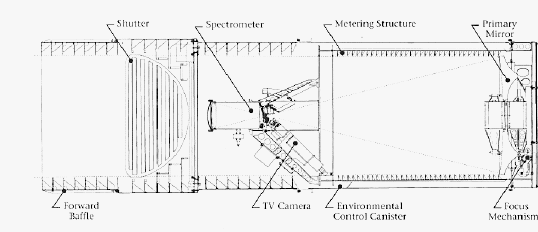|
|||||||||||||||||||
|
|
|||||||||||||||||||
|
|
Hopkins Ultraviolet Telescope Technical Summary

HUT Technical Summary
| Principal Investigator: | Dr. Arthur F. Davidsen |
| Developing Institution: | The Johns Hopkins University |
| Telescope Optics: |
90-centimeter (36-inch) aperture, f/2 focal ratio, silicon carbide-coated, parabolic mirror |
| Spectrograph: |
Prime-focus, Rowland-circle design using a 600 line/mm grating coated with silicon carbide |
| Spectral Resolution: | 3.0 angstroms |
| Wavelength Range: | 825 to 1850 angstroms (first order) |
| 420 to 925 angstroms (second order) | |
| Detector: | photon-counting |
| microchannel-plate intensifier | |
| cesium iodide photocathode | |
| 1024 element photo-diode array detector | |
| Time Resolution: | 1 ms in high time mode |
| 2 s in histogram mode | |
| Dark Count Rate: | 0.001 counts/Angstrom/s |
| Peak Effective Area: | 35 sq. cm at 1200 angstroms |
| Sensitivity: |
S/N of 10 per Angstrom in 1800 s for Flambda=3.3e-14 ergs/cm2/s/A |
| Weight: | 789 kilograms (1736 pounds) |
| Dimensions: | 1.1 meter (4 feet) diameter |
| 3.7 meters (12 feet) length | |
| Field of View of Guide TV: | 10 arc-minutes |
The Hopkins Ultraviolet Telescope (HUT) was designed and built by members of the Center for Astrophysical Sciences and the Applied Physics Laboratory of The Johns Hopkins University in Baltimore, Maryland. HUT consists of a 90-centimeter (36-inch) f/2 mirror that focuses light from celestial sources onto a prime focus spectrograph.
Covering the 825-1850-angstrom region with about 3-angstrom resolution, HUT opened the astrophysically important 912 to 1200-angstrom window to detailed scrutiny for the first time. In typical 1800 s integrations, HUT observed faint astronomical objects with visual magnitudes of about 16.
Originally designed to explore the far- and extreme-ultraviolet ranges on Astro-1, HUT was modified for Astro-2 to concentrate on the far-ultraviolet. The changes made to HUT for Astro-2 included a new detector system and new silicon carbide coatings on the mirror and grating which replaced the original iridium and osmium. These improvements provided a factor of 2.3 increase in sensitivity in the primary operating range of 825 to 1850 angstroms, especially in the 912- to 1200-angstrom region unique to HUT.
What is HUT? provides a less technical description of HUT for the general reader.
|
|
|




 Follow Us
Follow Us